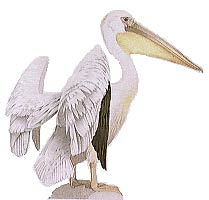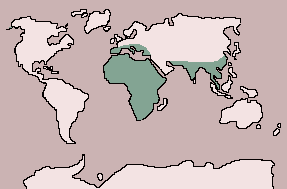Great White Pelican

| Class: Aves: Birds |
Diet: Fish |
| Order:
Pelecaniformes: Seabirds |
| Size: 140
- 175 cm (55 - 69 in) |
| Family: Pelecanidae:
Pelicans |
Conservation Status:
Non-threatened |
| Scientific Name:
Pelecanus onocrotalus |
Habitat: inland lakes,
marshes |
| Range:
Southeastern Europe, Asia, Africa |
 A
large white bird with the characteristic pouched bill, the great white
pelican is well adapted for aquatic life. The short strong legs and webbed
feet propel it in water and aid the rather awkward takeoff from the water
surface. Once aloft, the long-winged pelicans are powerful fliers, however,
and often travel in spectacular V-formation groups. The pelican's pouch
is simply a scoop. As the pelican pushes its bill underwater, the lower
bill bows out, creating a large pouch which fills with water and fish.
As the bird lifts its head, the pouch contracts, forcing out the water
but retaining the fish. A group of 6 to 8 great white pelicans will gather
in a horseshoe formation in the water to feed together. They dip their
bills in unison, creating a circle of open pouches, ready to trap every
fish in the area. Large numbers of these pelicans breed together
in colonies. The female lays 2 to 4 eggs in a nest of sticks in a tree
or on the grass. The young are cared for by both parents. A
large white bird with the characteristic pouched bill, the great white
pelican is well adapted for aquatic life. The short strong legs and webbed
feet propel it in water and aid the rather awkward takeoff from the water
surface. Once aloft, the long-winged pelicans are powerful fliers, however,
and often travel in spectacular V-formation groups. The pelican's pouch
is simply a scoop. As the pelican pushes its bill underwater, the lower
bill bows out, creating a large pouch which fills with water and fish.
As the bird lifts its head, the pouch contracts, forcing out the water
but retaining the fish. A group of 6 to 8 great white pelicans will gather
in a horseshoe formation in the water to feed together. They dip their
bills in unison, creating a circle of open pouches, ready to trap every
fish in the area. Large numbers of these pelicans breed together
in colonies. The female lays 2 to 4 eggs in a nest of sticks in a tree
or on the grass. The young are cared for by both parents.

  
|
